Kala Academy Auditorium Refurbishment – Using Genetic Algorithms
I PROBLEM STATEMENT
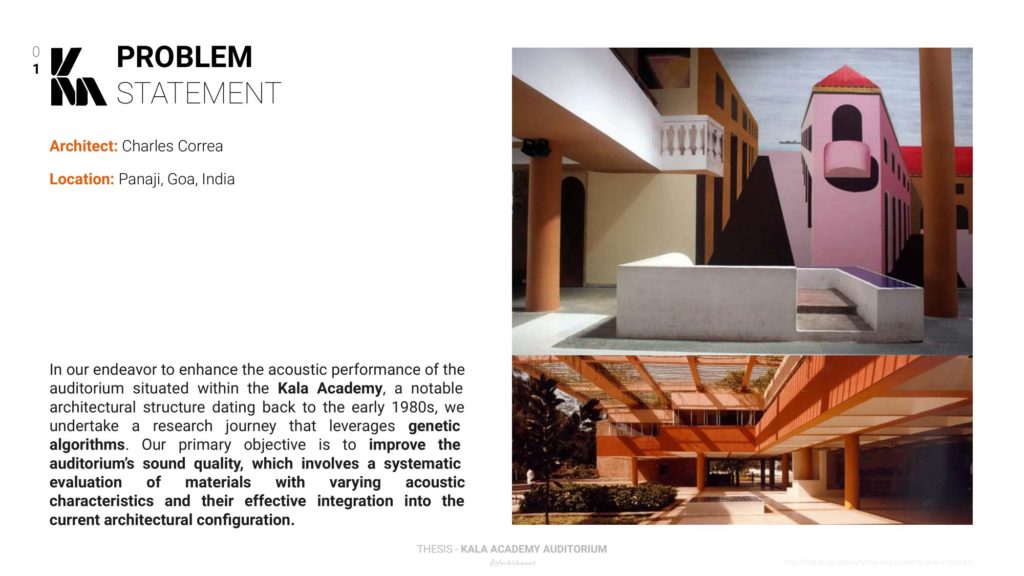
I STATE OF THE ART
EMPAC
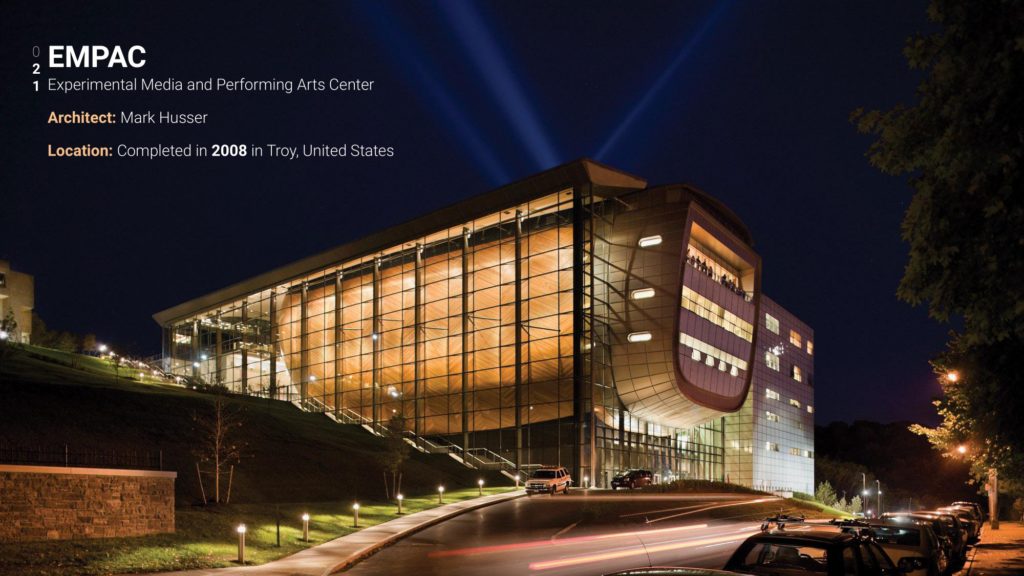
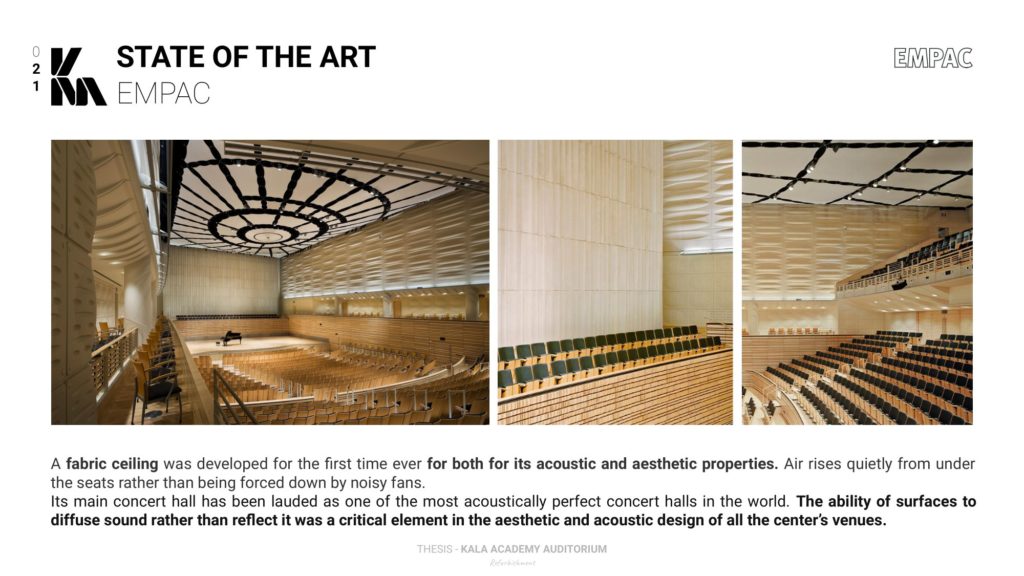

The interior was treated with various wall patterns applied to the walls leaving no flat surfaces to increase sound diffusion and decrease reverberation time, This made it rank as one of the most acoustically perfect concert halls in the world
QEB


In 2018 Queen Elizabeth Hall was refurbished to enhance the overall acoustics of the auditorium.
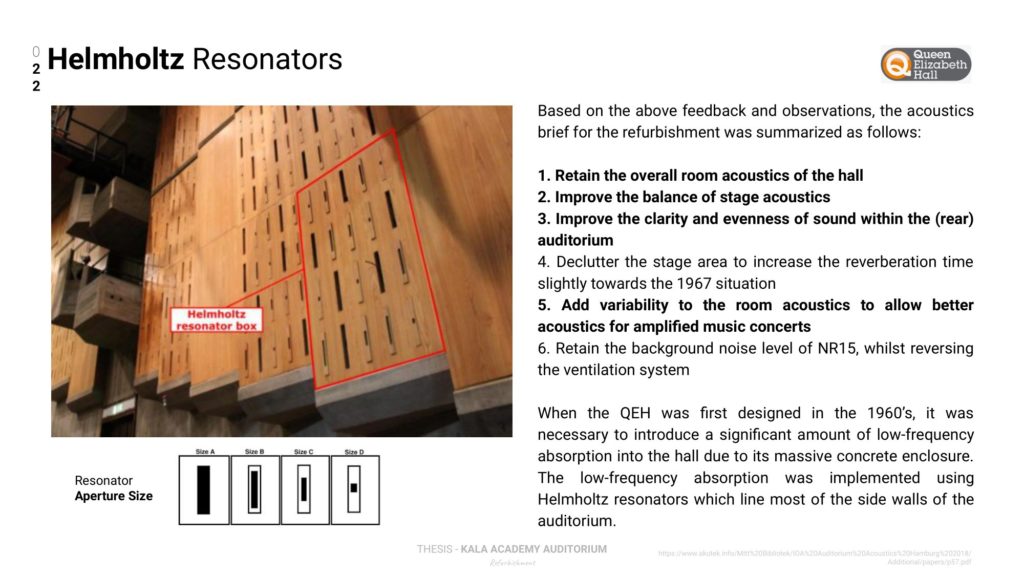
The refurbishment Focused mainly on absorbing low frequencies using Helmholtz resonators on most sidewalls since it is a massive concrete enclosure.
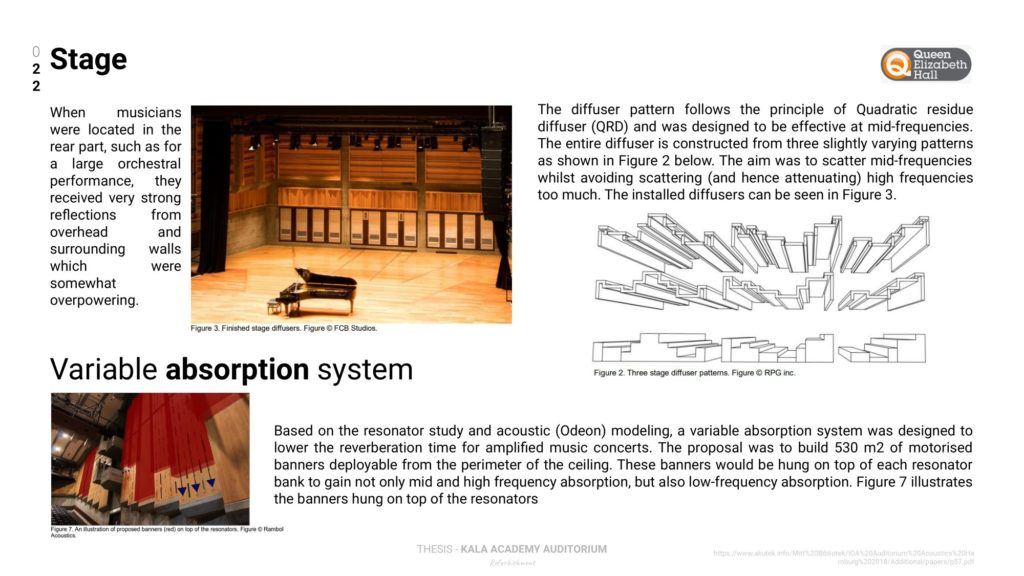
It also focused on Reducing sound reflections at the rear part, scattering mid frequencies using quadratic residue diffusers as seen in Fig 2. and most importantly lowering reverberation time
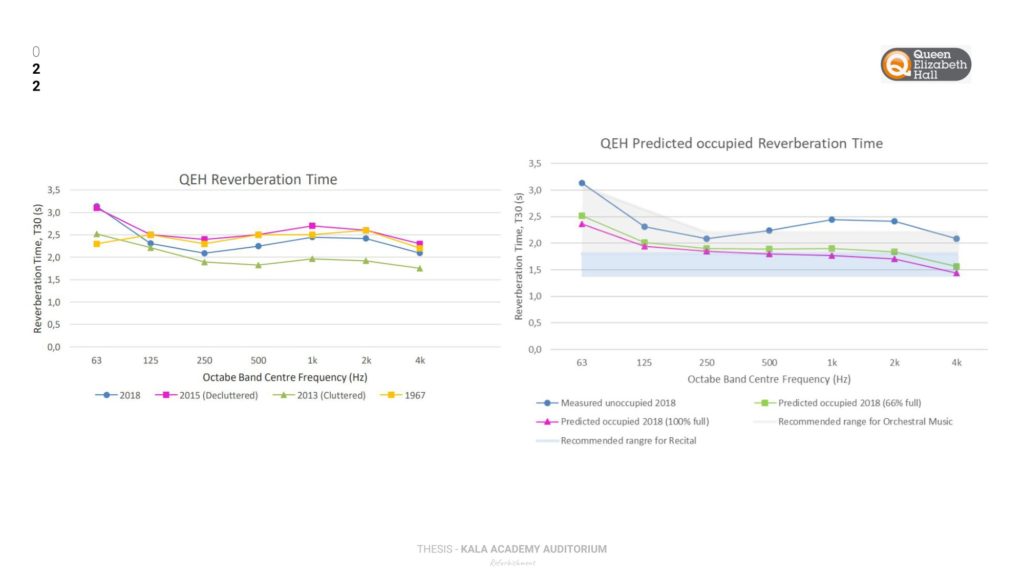
As we can see the graph on the left indicates a decreased RB time after the refurbishment in 2018 compared to 2015. On the right, the RB time has reduced more than the predicted one for 66% and 100% occupancy than the RB time calculated for the unoccupied auditorium Thus resulting in improved acoustic performance.
I KALA ACADEMY AUDITORIUM

The Kala Academy Auditorium was completed in 1983. It was set up to promote the cultural unity of the territory in the fields of music, drama, dance, literature, fine arts, etc.

The interior walls of the auditorium are painted illusions completed with boxes and inhabitants. Behind the figures in the boxes, real curtains were pulled to reduce reverberation time in space.
I ROADMAP
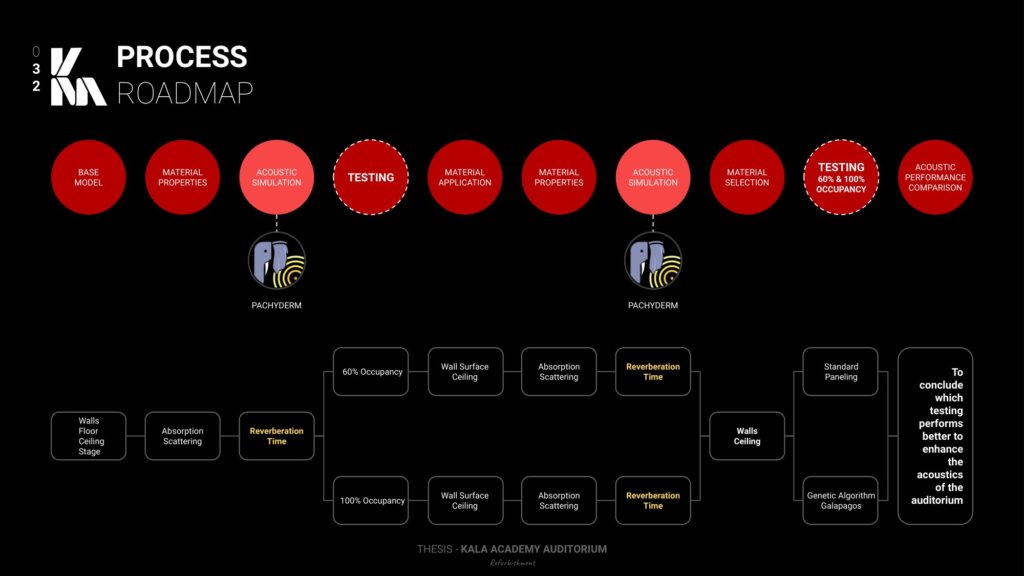
- As for our process, we started off with the base model of the auditorium
- Then explored different materials and their properties of absorption and scattering coefficients
- Followed by testing for 60 and 100% occupancies in order to get the best combination of materials for the wall and ceiling panels.
- These materials are again tested with standard panelization and with parametric geometries using a genetic algorithm with Galapagos.
- After testing we conclude which material combination and panel optimization performed better with acoustic performance.
I KEY ACOUSTICS TERMINOLOGIES
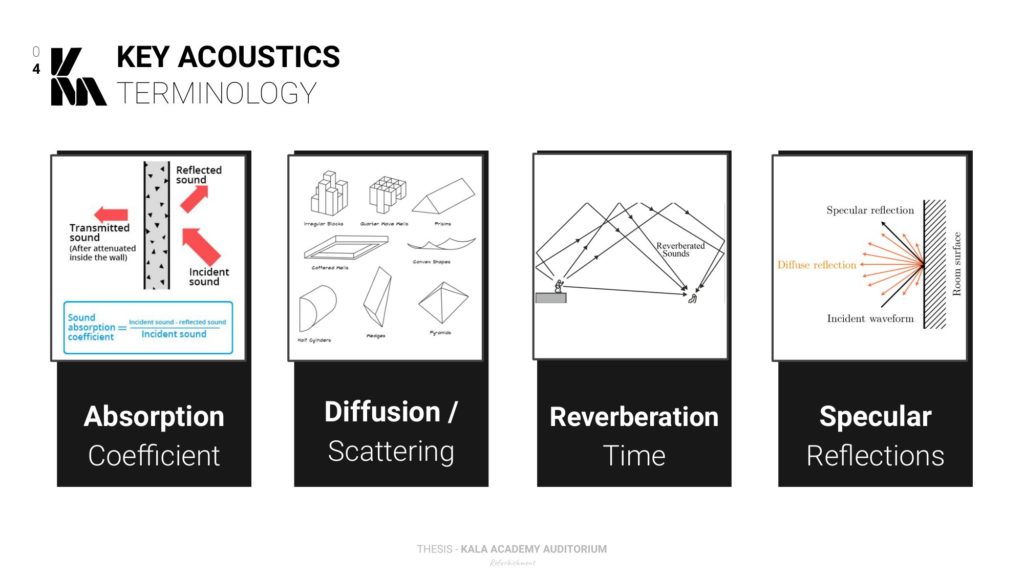
For our refurbishment process, there are 4 key acoustic definitions we took into account

The absorption coefficient, that is a measure of how effectively materials absorb sound waves ranging from 0 to 1.
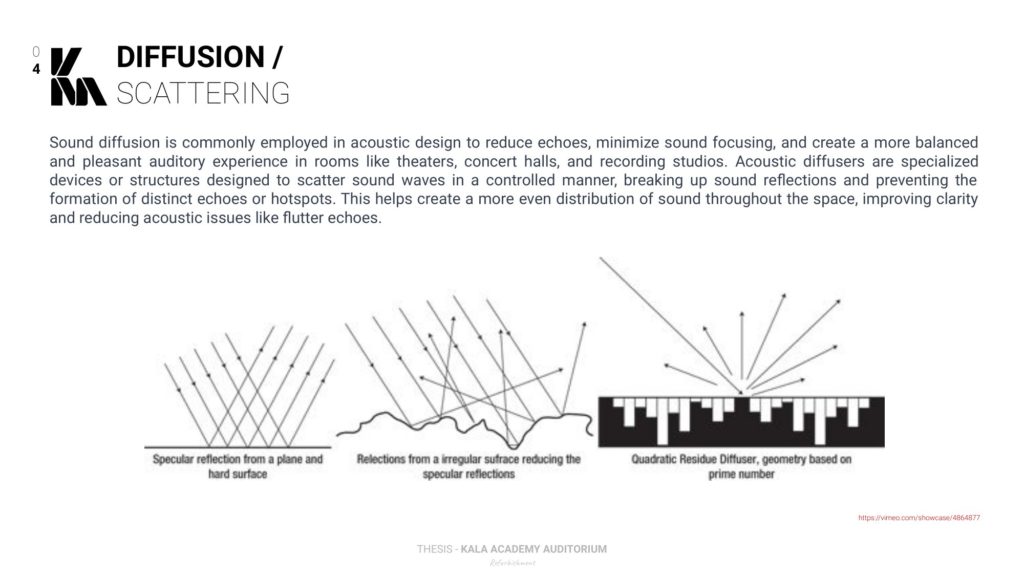
Sound diffusion to reduce echoes, minimize sound focusing, and scatter sound waves in a controlled manner to improve sound clarity and reduce flutter echoes.
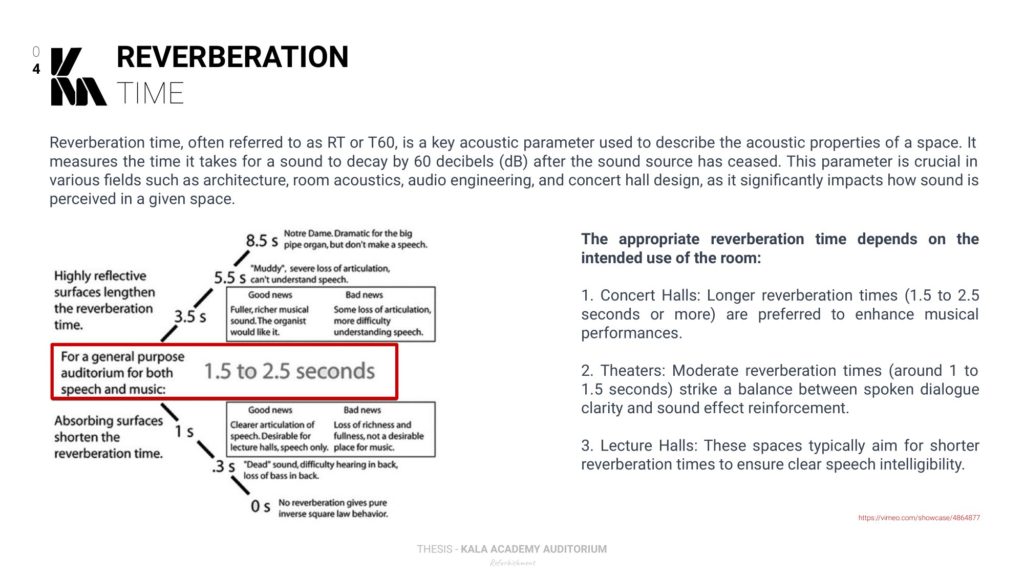
RB time which is the key acoustic parameter used to describe the acoustic properties of a space. It measures the time it takes for a sound to decay by 60 decibels after the sound has ceased. For general purpose auditorium for speech and music time ranges between 1.5 to 2.5 seconds.
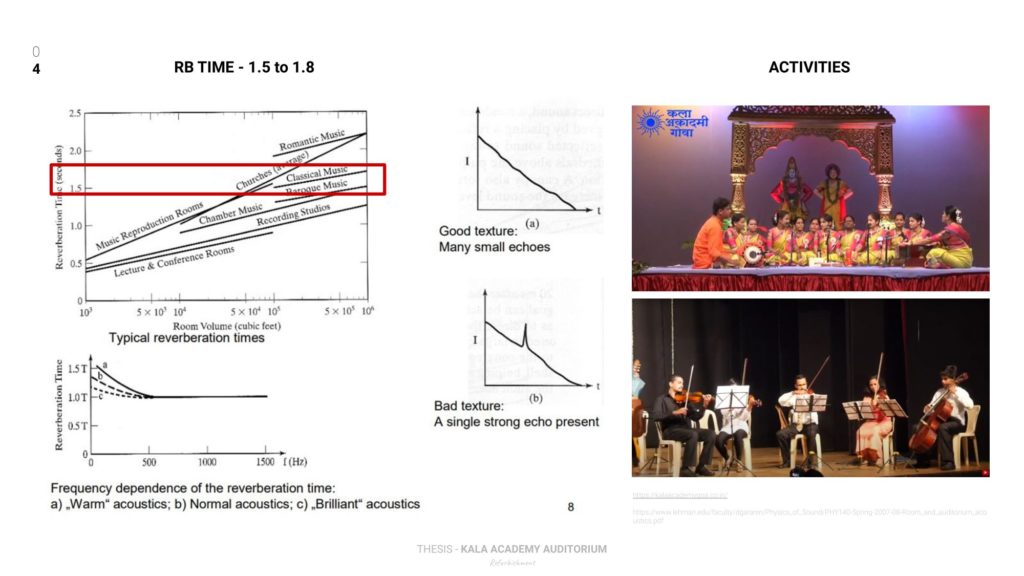
But in our case, the activities in the auditorium include classical music and a Western orchestra. Thus the reverberation times have to be optimized to range between 1.5 to 1.8 seconds for better acoustic performance.
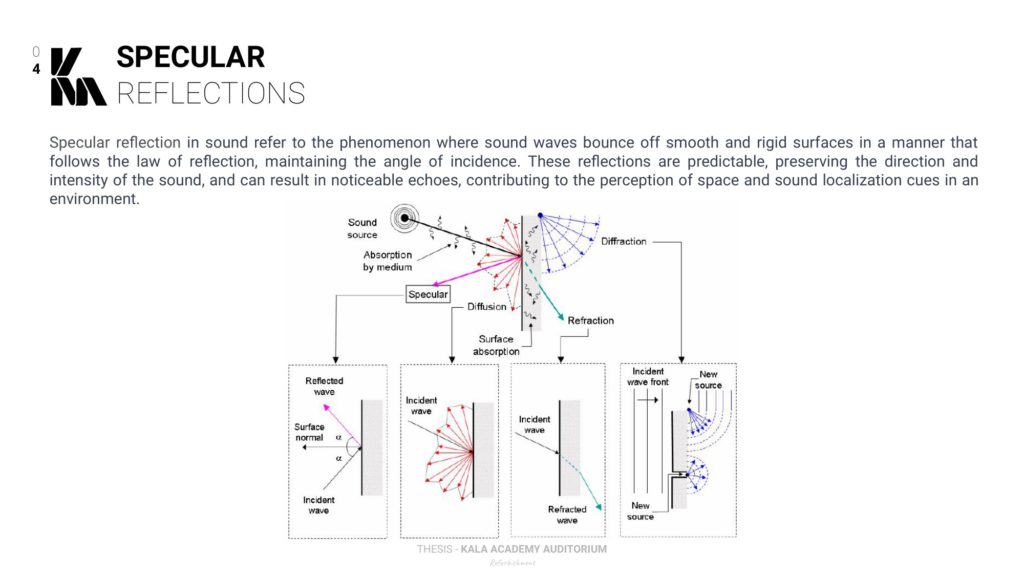
Specular reflections are Predictable and organized sound wave reflections off smooth, hard surfaces, obeying the law of reflection. These reflections are predictable, preserving the direction and intensity of the sound, and can result in noticeable echoes
To minimize or control the impact of specular reflections in acoustic design acoustic treatments and architectural features like diffusers, absorbers, and diffraction grating are employed to manage sound reflections, reduce echoes, and create an optimal listening environment.
I WORKFLOW

For the retrofit project, the base model was modeled as per existing conditions. The walls have a painted finish and the ceiling has gypsum ceiling tiles.
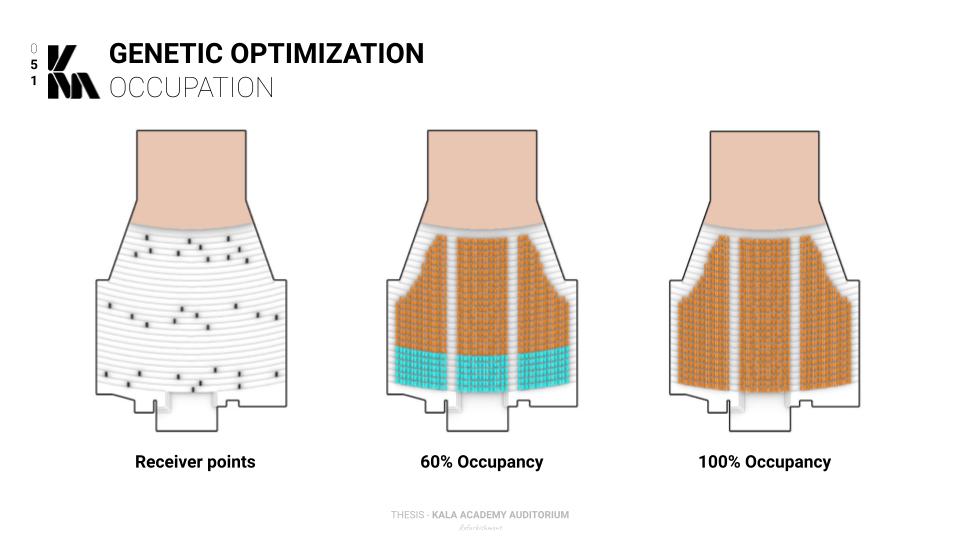
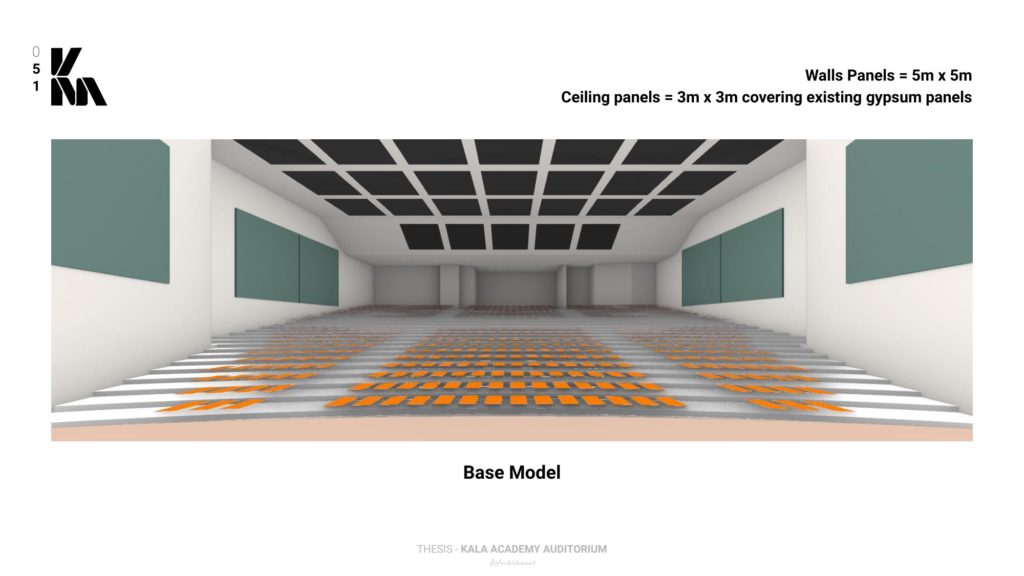
For the first series of testing, 5x5m wall panels were introduced and the existing ceiling has been covered with 3x3m ceiling panels. Different combination of materials was applied to find the best combination which would result in better acoustic performance.
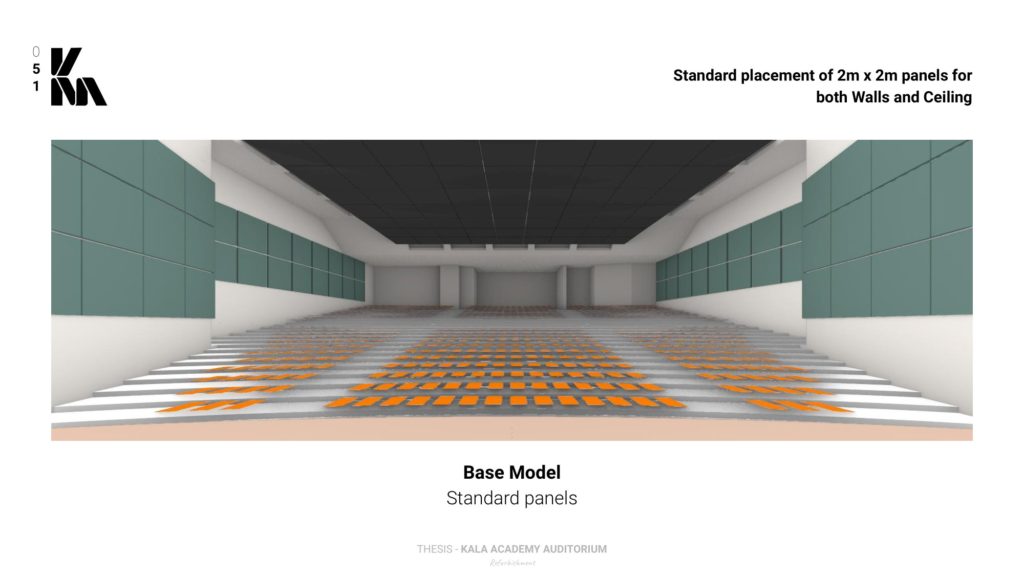
For the second series of testing the best combination of materials is chosen and applied to a set of standardized panels of 2x2m for both the walls and the ceiling. The selected combination was tested for 60% occupancy rate and 100% occupancy rate for the auditorium.
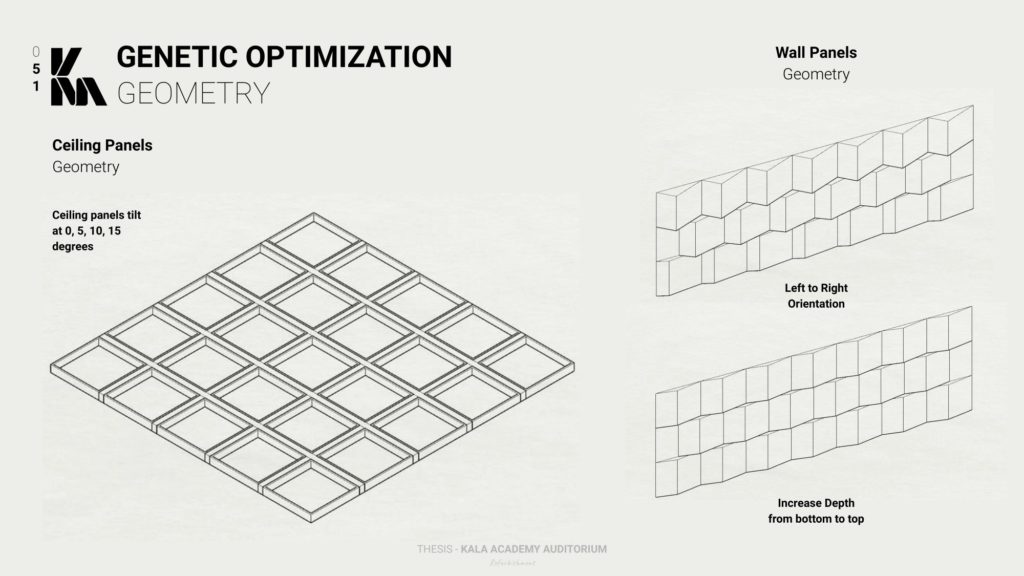
For the third series of testing, we were looking into geometries for panelization, and the same selected materials were used for testing. Our approach for the penelization was inspired by the existing auditorium where the architect had used waffle slabs and the voids were covered with gypsum panelling. The existing ceiling is the most recognizable feature of the auditorium.
We have three criterias determining the overall geometry. Two factors affecting the wall panelization and one affecting ceiling panelization.
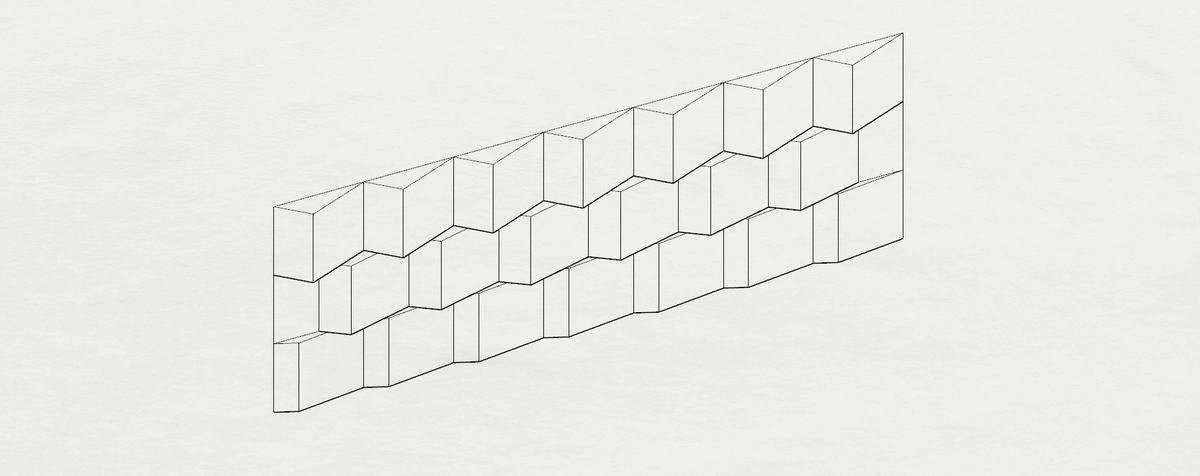
Left to Right Orientation

Increase Depth from bottom to top
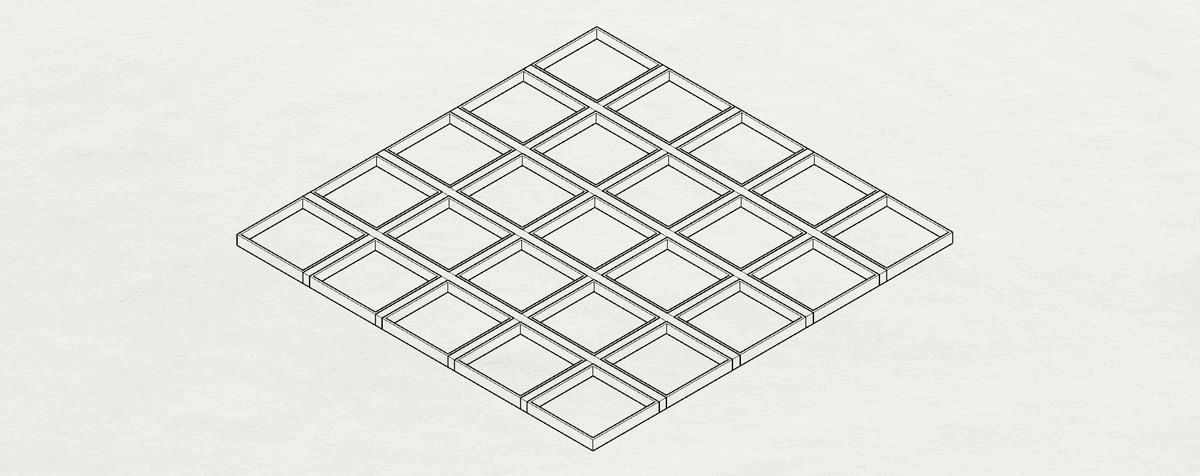
Ceiling panels tilt at 0, 5, 10, 15 degrees

For our first criterion, wedge shaped configuration that would move from left to right having four iterations.

For our second criterion, the depth of the wall increases from the bottom to the top. The other way around would obstruct the pathway to the auditorium seats. The depth would provide an uneven surface to provide more scattering of sound.
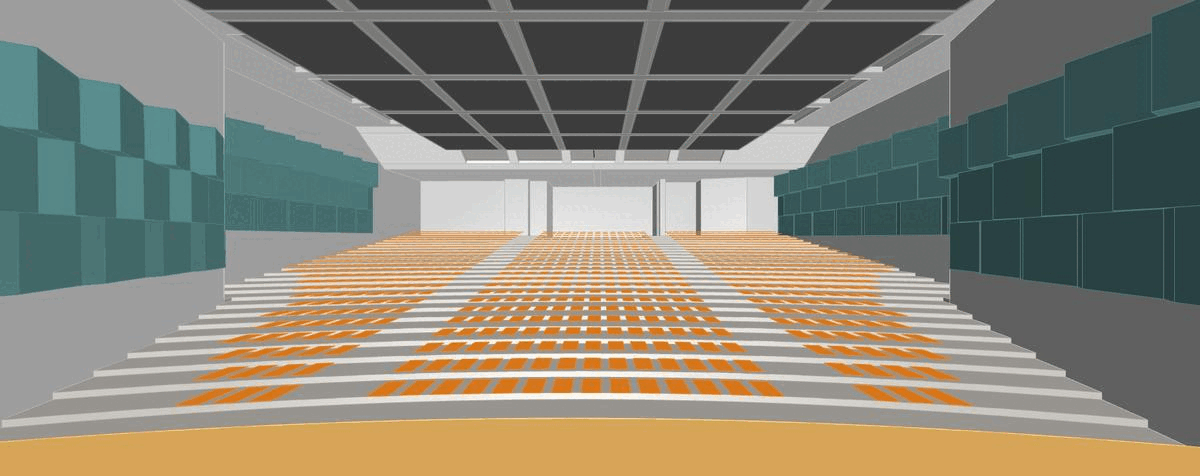
For our third criterion, the ceiling panels would tilt at 0, 5, 10, and 15 degrees angles.
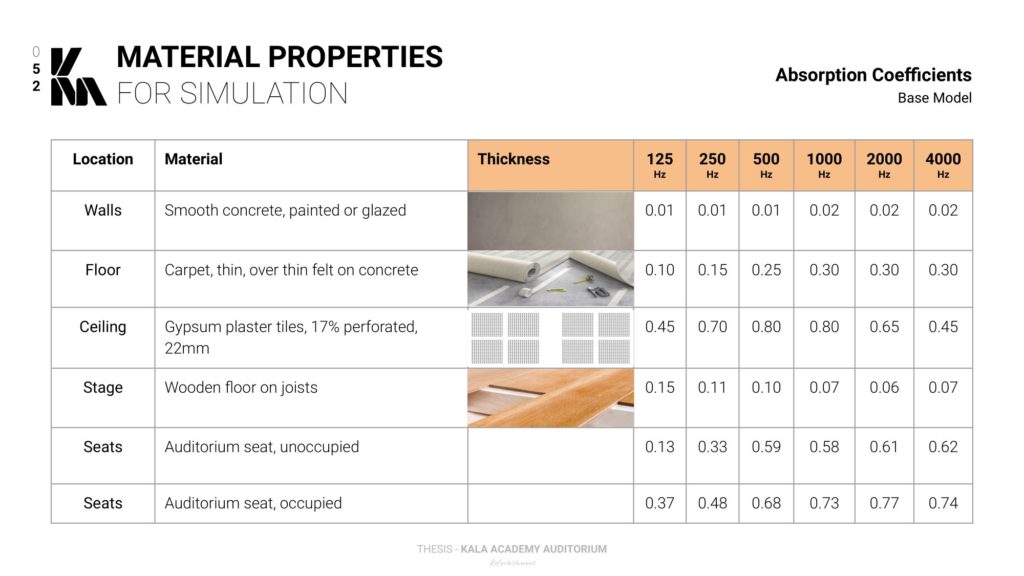
For the acoustic simulations, we used the pachyderm acoustics plugin from Grasshopper, which requires the values for absorption and scattering coefficients of the materials to run the simulations. The materials considered are walls with a painted finish, carpets for flooring, Gypsum panels for the ceiling, Wooden joists for the stage, seats occupied or unoccupied, and its absorption coefficient values for all octave wavelengths, for the existing base auditorium model.
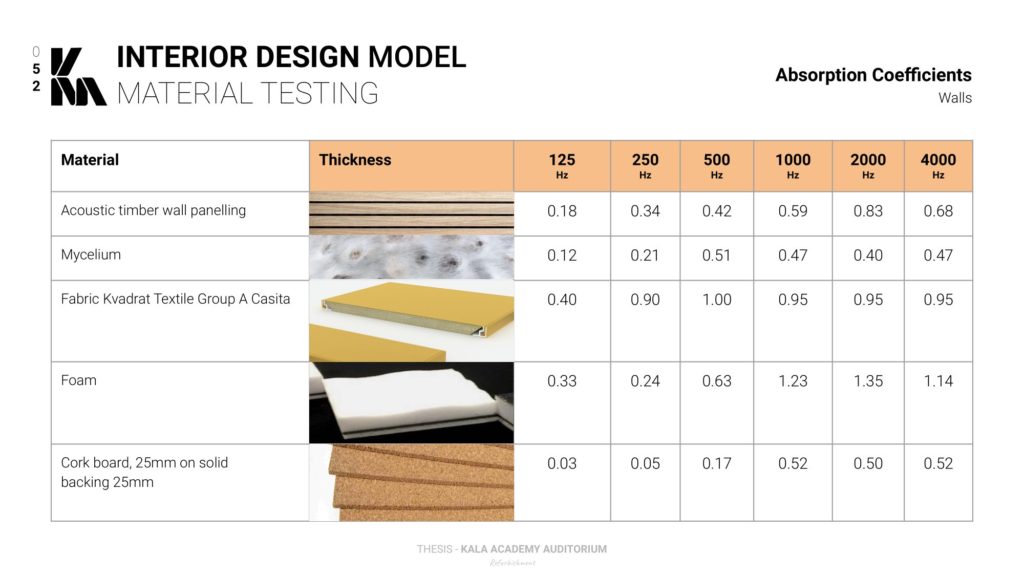
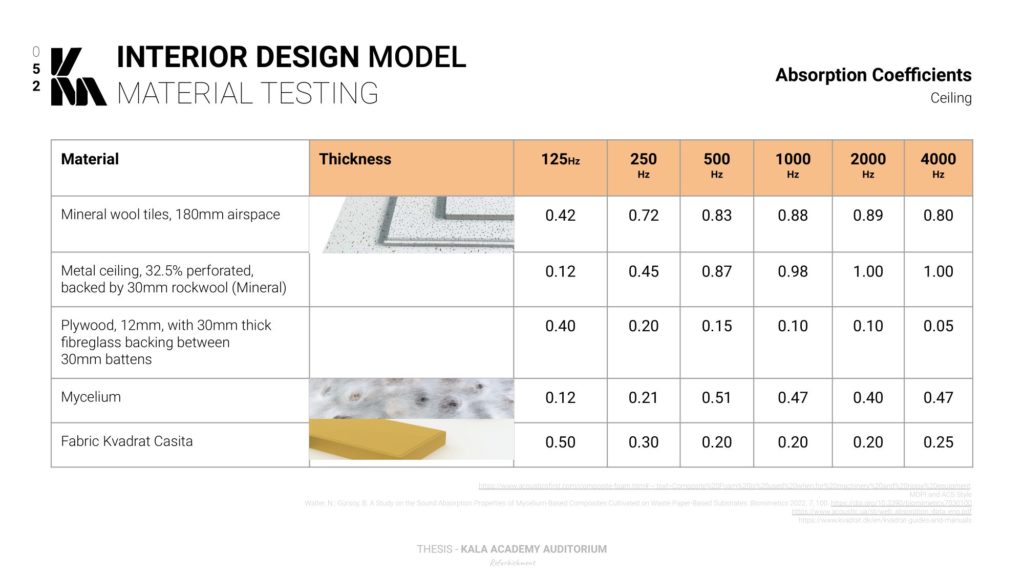
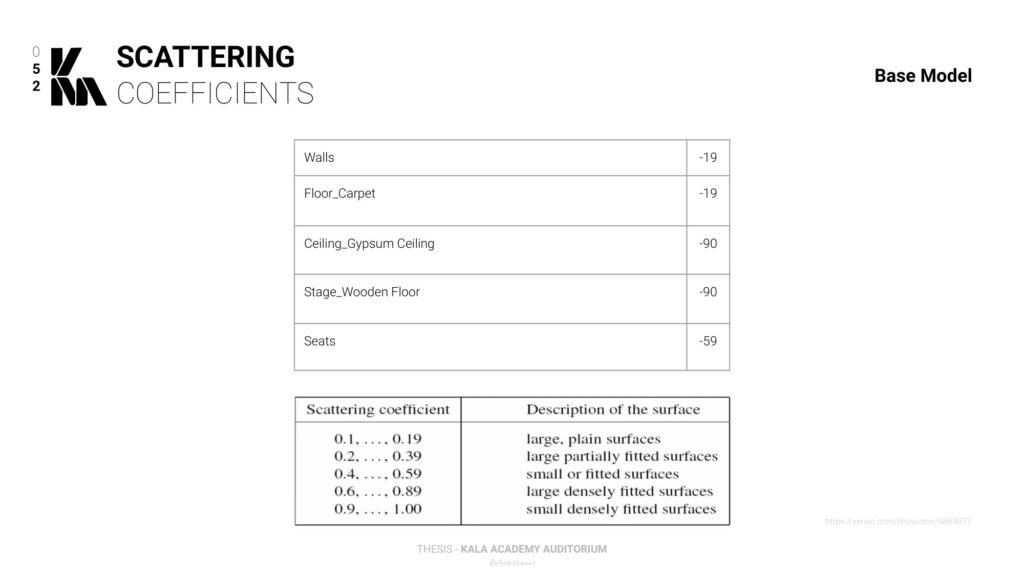
The scattering coefficient is based on the size of the surface and how they are fitted together on the plane. For the base model, since the walls and floor carpets have large surfaces they have low scattering coefficients, but the ceiling, stage, and auditorium seats have smaller surfaces, therefore the scattering coefficients are more.

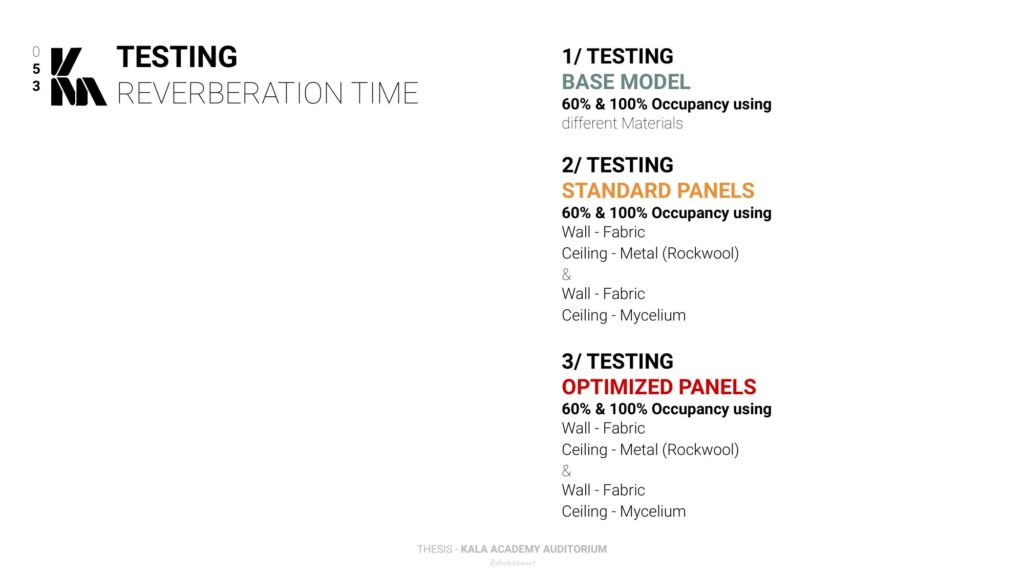

This is the first series of tests with different combinations of wall and ceiling panel materials with 60% occupancy.
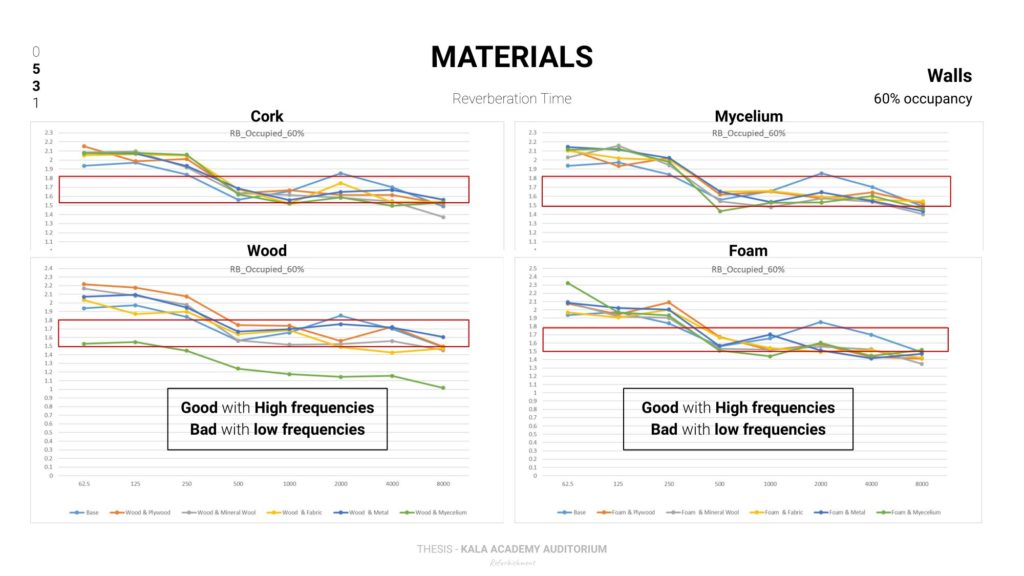
The Dark blue line indicates the reverberation times for the base model and we are trying to get a linear graph that would be inside the range of 1.5 to 1.8 seconds. The material combinations of Wall panels Cork, Mycelium, Wood, and Foam with the ceiling panels don’t perform well as the reverberation times are longer for the low frequencies.

The material combination of Fabric wall panels with ceiling panels of Metal (Rock wool) and Mycelium performs better as most reverberation times for different wavelengths are well inside the range of 1.5 to 1.8 seconds.
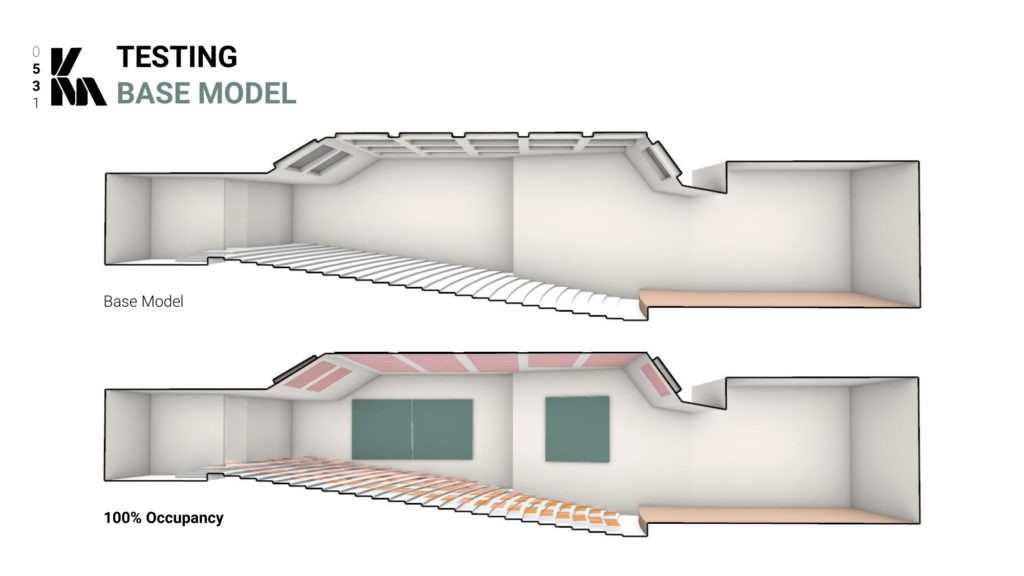
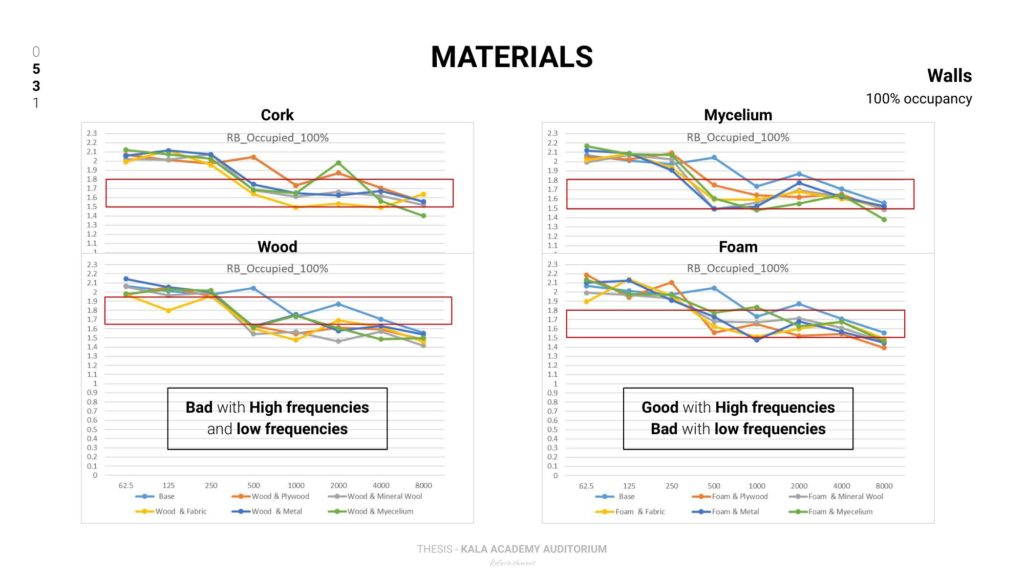
At 100% occupancy the wall panels with cork & wood would perform badly with high and low frequencies and the wall panels with Mycelium and foam would perform well with high frequencies but not with lower frequencies.

Here it can be concluded that upon testing the wall panels with fabric perform well acoustically with the ceiling panels of either Metal with rockwool backing or mycelium.
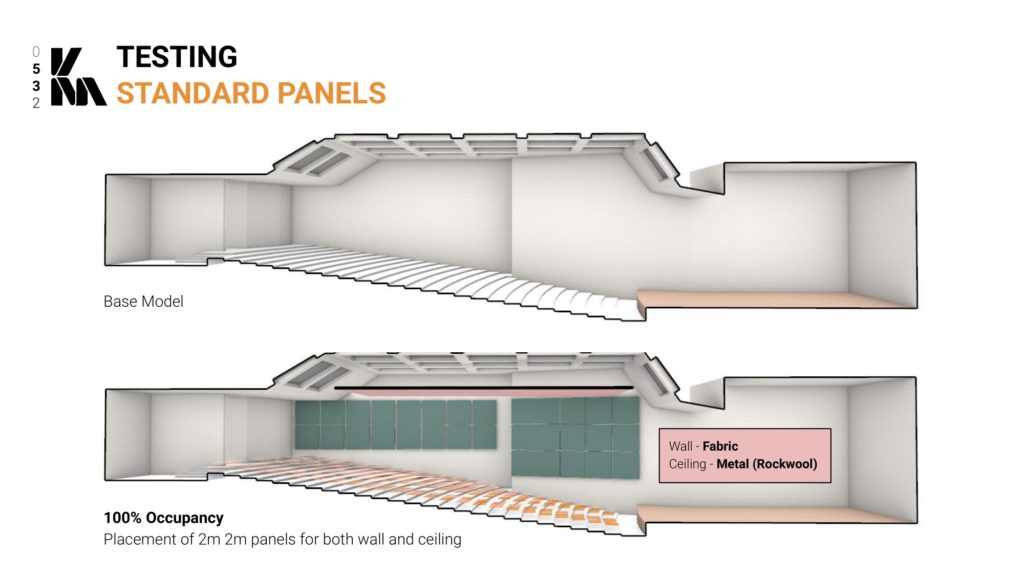
For the second series of testing, we go into standardized panels starting with the combination of fabric wall panels and Metal with Rockwool ceiling panels.
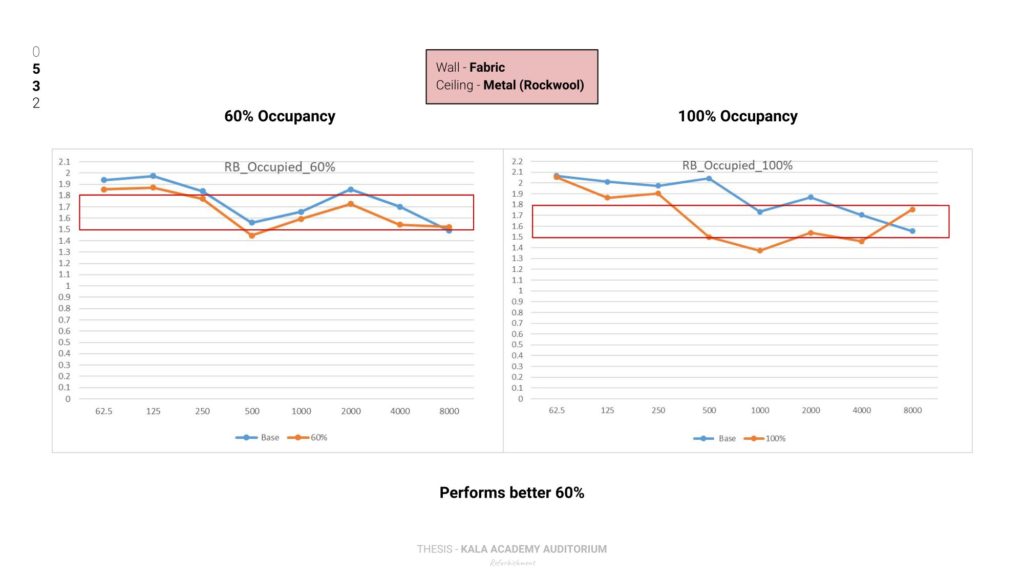
It can be concluded that this combination performs better at 60% occupancy but not so with 100% occupancy.
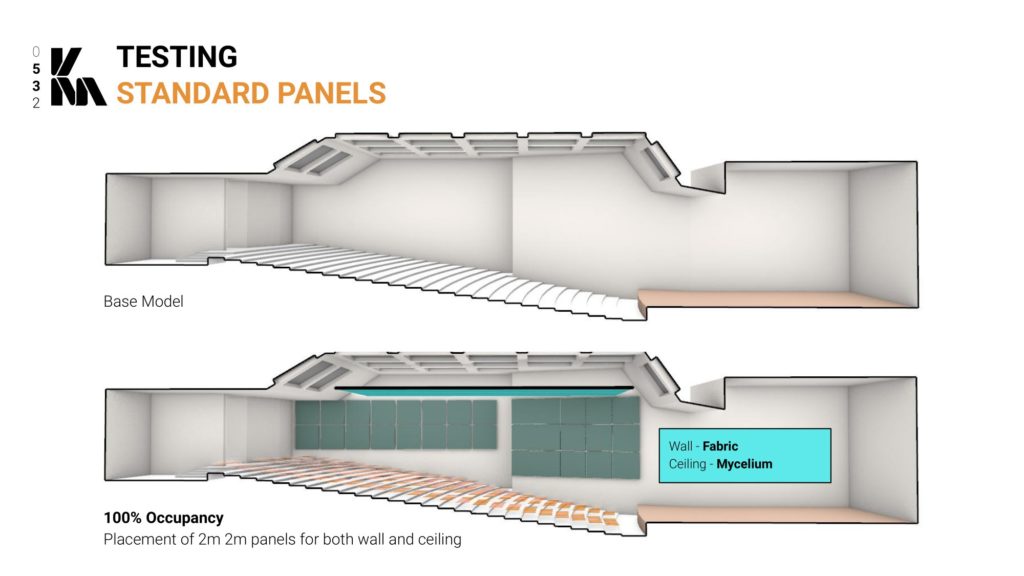
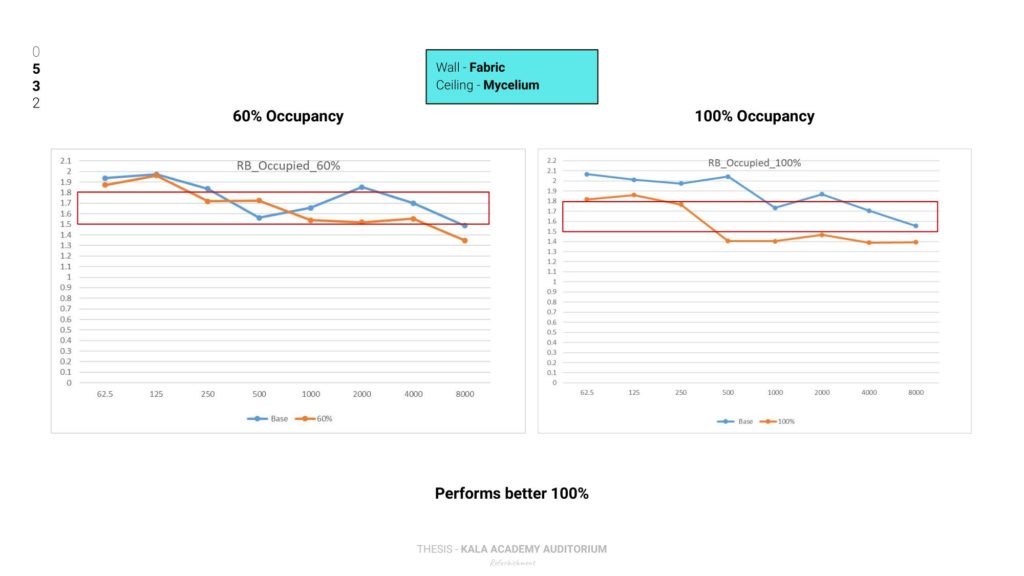
It can be concluded that this combination performs better at 100% occupancy but not so at 60% occupancy.
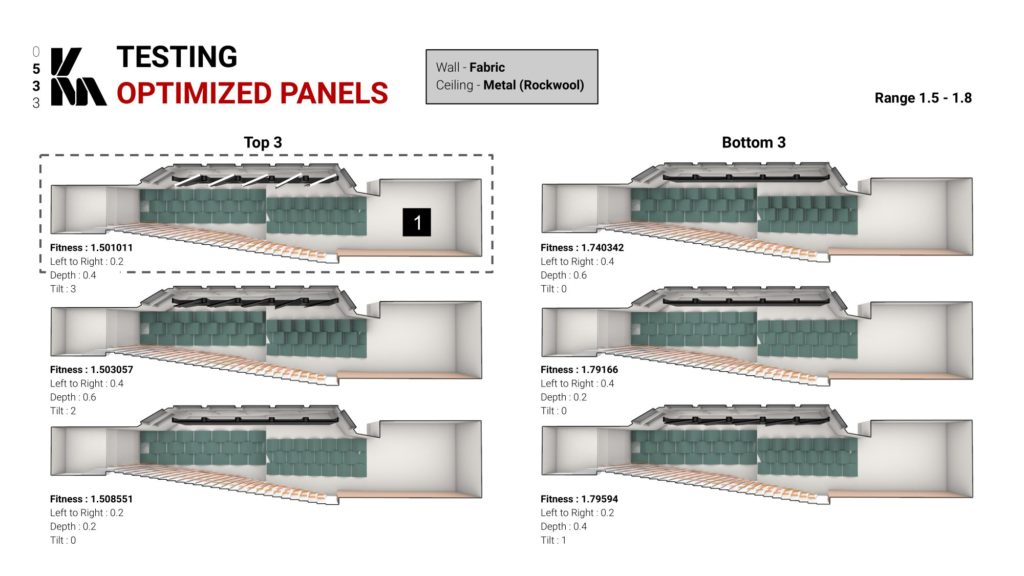
For the third series of testing, we looked into genetic algorithms using Galapagos which is a single objective optimizer, to find the best fitness values that would increase the acoustics performance. It was noted that when the panels are oriented towards the left with a considerable depth and with more tilt on the ceiling panels, the Reverberation times lower with an increase in acoustic performance. For this testing, the top 3 fitness values and the bottom 3 fitness values were considered.

Clearly, the first fitness performed better for both 60% and 100% occupancy rates for the fabric wall panels and Metal with Rockwool backing ceiling panels.
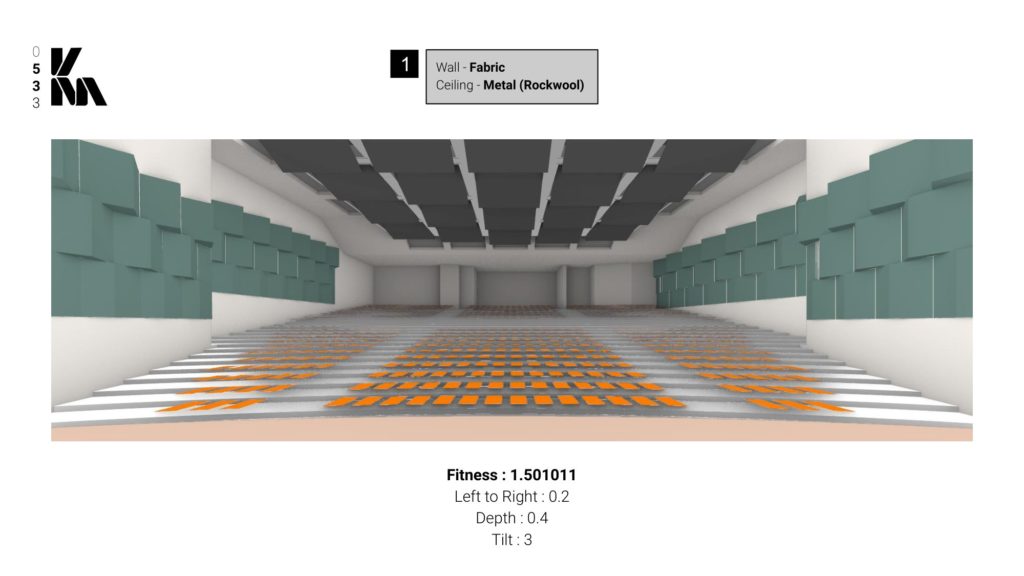
View for the first fitness
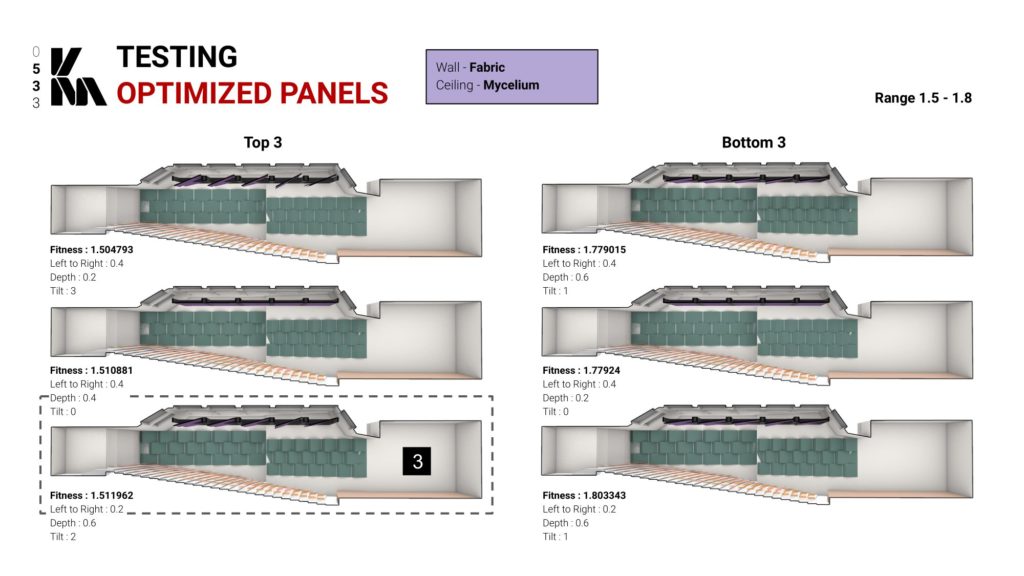
For the fabric wall panels and Mycelium ceiling panels, the Top 3 and the bottom 3 fitnesses were tested.
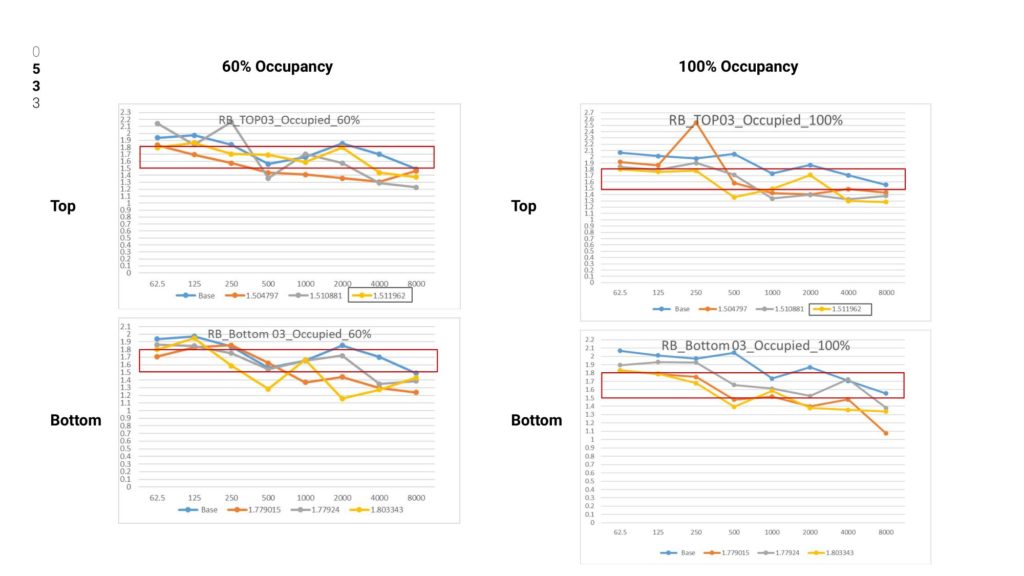
The third fitness was more optimized for the reverberations times than the first fitness and from here it can concluded that the best fitness may not be the best-performing fitness.

View for the third fitness
I PARTICLE SIMULATIONS
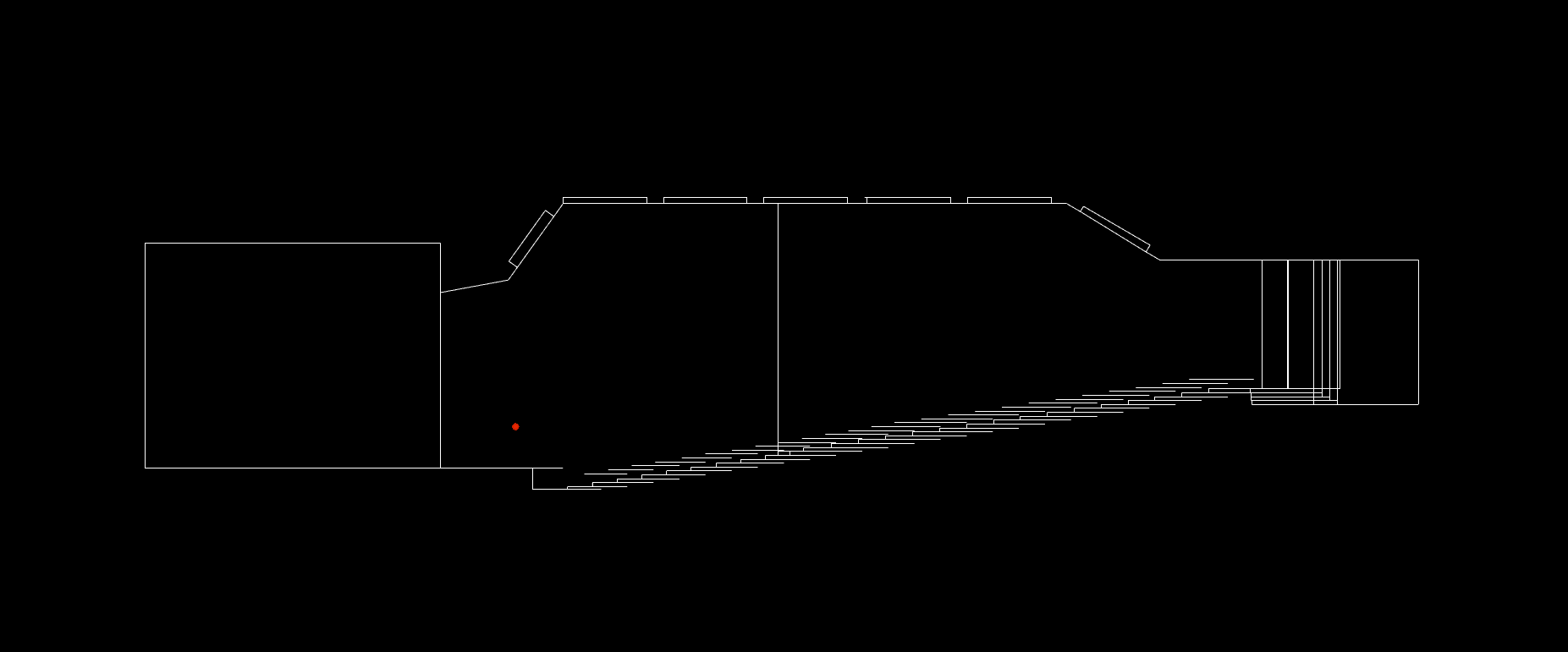
Base Model
The particle simulation gives an idea of how sound is scattered within the space. As seen in the base model there are a lot of specular reflections of sound after bouncing off the ceiling which would increase the reverberation time.
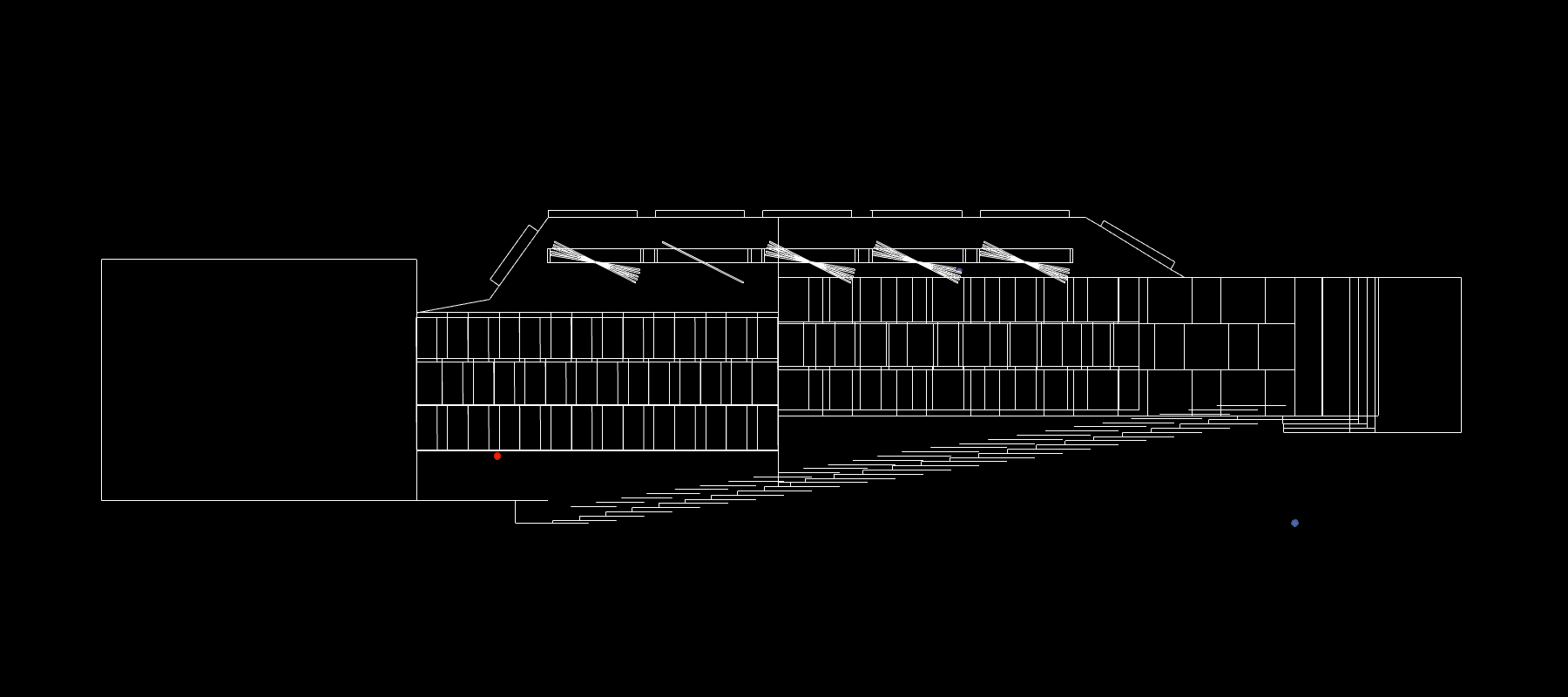
Fabric & Metal with Rockwool backing
After the introduction of the wall panels and the ceiling panels, the specular reflections have decreased which leads to less reverberation times and better acoustic performance.

Fabric & Mycelium
I RENDERS
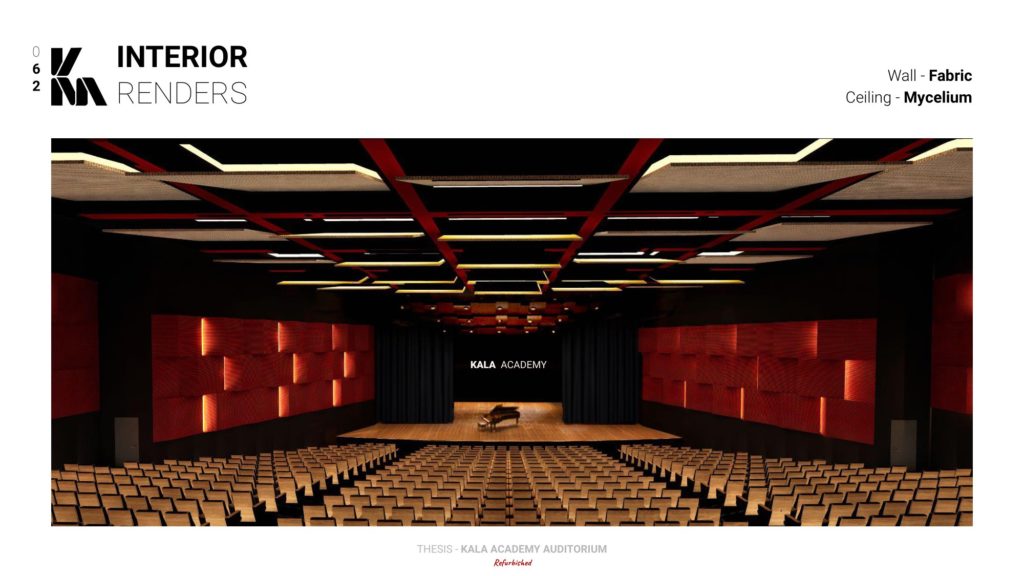
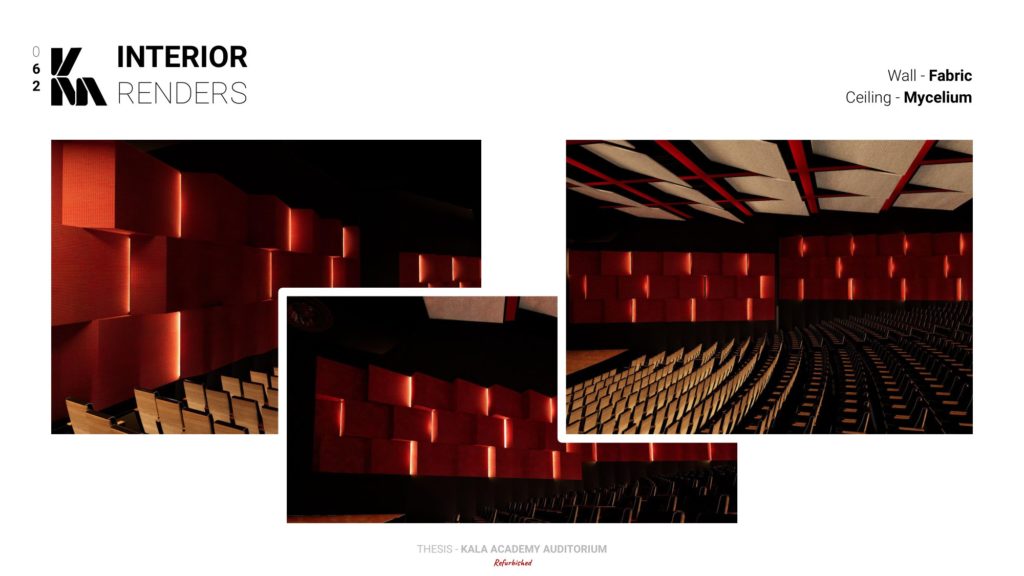
I CONCLUSION
- The optimized wall and ceiling panels performed better acoustically with respect to the reverberation times for 60% and 100% occupancy than the standardized panels.
- The workflow helps to filter out geometries and material selections with the performance objective of reverberation time for acoustics.
I FUTURE DEVELOPMENT
- A similar workflow can be used for performance-driven design with different sets of objectives like material usage, costs, energy consumption, carbon sequestration, etc.
I DRAWBACKS
- Unable to run multi-objective simulations with a combination of objectives like Reverberation time, and material usage as acoustic simulations are computationally very heavy.
- Cannot run too many objectives with an increased number of iterations, as the simulation will keep on running and would not conclude.

